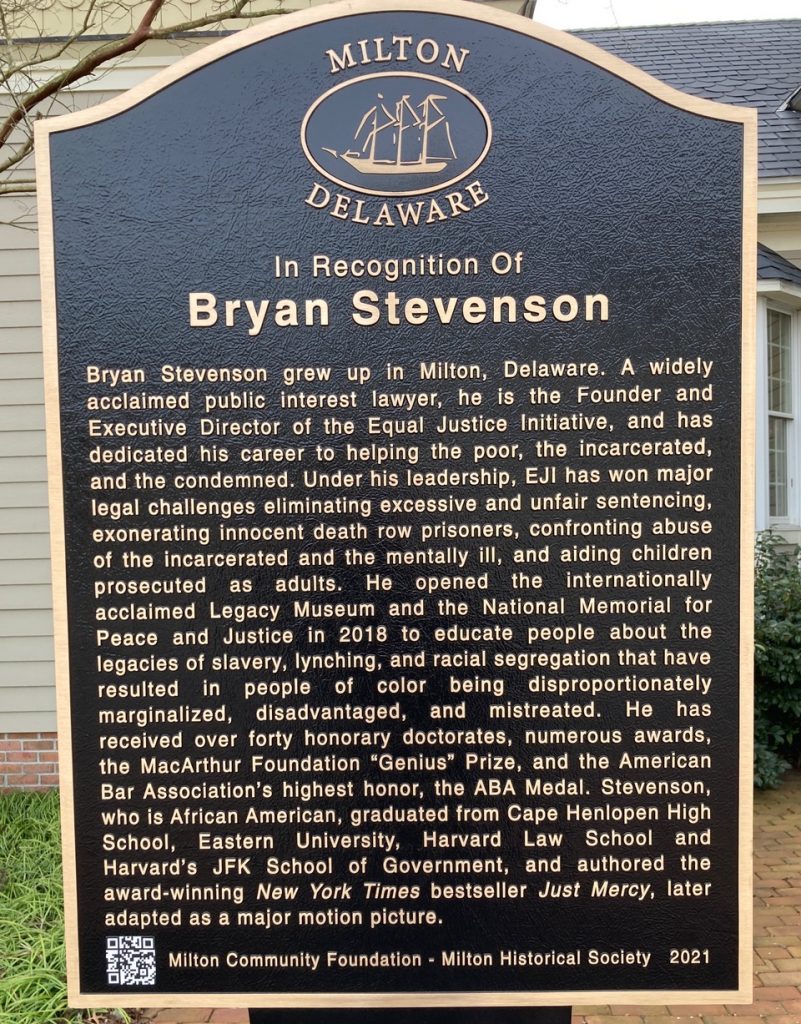One year after Del. native honored for challenging inequality, Milton community leaders weigh in
Last year, Milton native Bryan Stevenson was honored with a historical marker in his hometown after decades of challenging inequality in the American judicial system.

Stevenson, an activist, lawyer and author, has spent decades challenging inequality in the American justice system. He founded the Equal Justice Initiative in 1989, which provides legal representation to those who may have been denied a fair trial. Stevenson started the National Memorial for Peace and Justice and The Legacy Museum: From Enslavement to Mass Incarceration in Montgomery, Alabama, as tribute to over 3,000 African Americans lynched in the deep south during Jim Crow.
Hear below from Steve Crawford, president of the Milton Community Foundation, and DeeDee Wood, director of the Milton Historical Society, to learn more about the importance and impact of Stevenson’s hometown recognition a year later.
Why is this historical marker significant?
Crawford: The plaque is significant in that it celebrates and educates. It celebrates a Miltonian who has made a very significant impact for equal justice. It educates by explaining what Bryan has achieved and what he continues to strive for. The words on the plaque pretty much say it all.
Wood: This historical marker is significant because, as Stevenson himself said, “the Milton community helped instill in me the ability to dream big.” It is a tangible, interpretive representation of his roots in Milton, the foundation that built his ambitions and an embodiment of his accomplishments and achievements with social justice and equality.

What do you want people to know about Bryan Stevenson and the marker?
Crawford: At the dedication, Bryan spoke about his childhood experiences. He told us that his family stressed education. While other kids would get toys for Christmas, he and his siblings would get books.
Wood: Bryan Stevenson and the marker are both significant for past, present and future historical reference and pride for the town of Milton, Delaware. Stevenson, as a social justice activist, professor, founder of a multitude of organizations and other accolades, is the embodiment of courage, strength, mercy, compassion and justice. The marker, in some ways, represents his voice and voices of all those who have benefited from and are inspired by his public and private justice work, and will forever tell the narrative of his important endeavors.
How important is this part of history to the area?
Crawford: As a small town in a small state, it’s important to celebrate an individual who was born, raised, educated and excelled in the Milton community.
Wood: The history surrounding Bryan Stevenson to this area is extremely important. His experience growing up as a young man involved the history of segregated schools in Milton, racial integration of classes when he was in elementary school locally and the changing face of social justice in this area would prepare him for future endeavors. A graduate of Cape Henlopen High School, locally, and a Harvard law graduate, Stevenson went on to found the Equal Justice Initiative in Montgomery, Alabama, that challenges sentencing structure of inmates, exonerated innocent prisoners, confronted abuse in the system, among other important things in the realm of social justice and human rights. As well, he was instrumental in opening two sites, the Legacy Museum and the National Memorial for Peace and Justice, among many other outstanding achievements.
How has the marker been received by the public?
Wood: The plaque had a special unveiling ceremony a year ago, with Stevenson himself attending, and including representatives from the Milton Community Foundation, the Milton Historical Society, state and local representatives and other organizational representatives. The plaque has a prominent position for viewing in front of the Milton Historical Society, in the heart of the historic district in Milton, It is visited often, with many guests and visitors of the museum asking questions about Bryan Stevenson, his legacy, his important work for justice and more. The plaque is in a high traffic area of the museum grounds and is regarded and considered quite often.
What should people know about the Milton Community Foundation and its role in getting the marker?
Crawford: The idea to honor Bryan came about as a suggestion by a Milton Community Foundation board member. The MCF Board considered the idea and with really not much discussion, we worked to make the idea a reality. We needed to raise money for the initiative and reached out to Tim Slavin, former director of the Delaware Division of Historical and Cultural Affairs. He immediately bought into the initiative and provided all the necessary funding for not only the plaque but also the dedication event.
After developing the idea of a plaque, we worked with Bryan to ensure the wording was satisfactory to him. In addition, we started planning for the dedication event and where the plaque could be placed. We reached out to the Milton Historical Society to inquire about placing the plaque at the museum property. We created a memorandum of understanding whereby the MCF would procure the plaque and the MHS would assume ownership after it was installed. In addition, they agreed to host the dedication event.
What else do you want people to know about the Milton Historical Society?
Wood: We are proud of our mission statement at the historical society, and believe history is for everyone who wishes to learn about their past.
“The Milton Historical Society is a nonprofit cultural and educational organization dedicated to increasing public understanding and appreciation of the history of Milton and the Broadkill Hundred. The Society collects, preserves, and interprets stories, artifacts and documents related to Milton and the Broadkill Hundred for study and education. We welcome the participation of people of all ages in sharing informative and engaging experiences that will encourage them to discover and appreciate their heritage.”
To learn more about the Milton Community Foundation, go to miltoncommunityfoundation.org.
To learn more about the Milton Historical Society, go to historicmilton.org.
Stevenson, who has been recognized for his laudable efforts in recent years, also is a recipient of the Benjamin Franklin Medal from the American Philosophical Society. In 2020, he shared the Right Livelihood Award with international activists Nasrin Sotoudeh, Ales Bialiatski and Lottie Cunningham Wren. He also is widely known for his 2014 New York Times bestselling book, “Just Mercy: A Story of Justice and Redemption,” and the 2019 film adaptation. The book is Stevenson’s memoir, documenting his career defending disadvantaged clients. The story focuses on injustices in the United States judicial system, specifically highlighting Stevenson’s efforts to overturn the wrongful conviction of Walter McMillian, as well as his work on other cases defending poor or marginalized clients.


